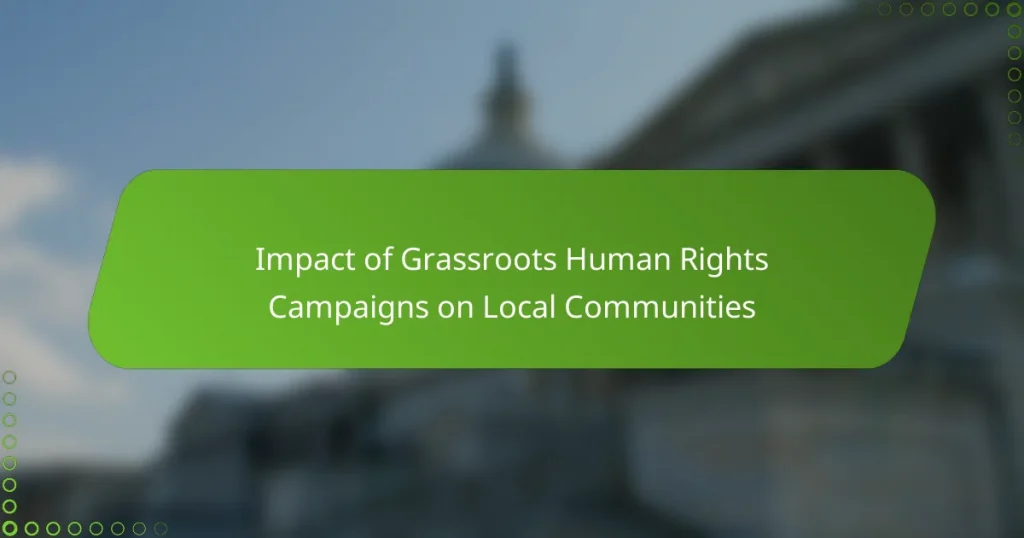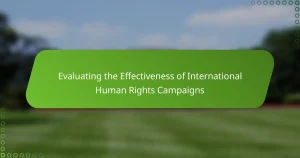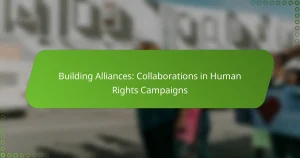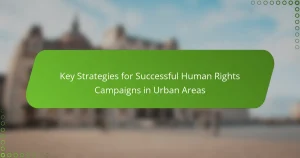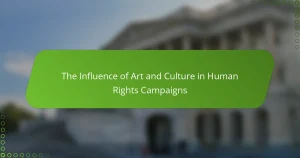Grassroots human rights campaigns are community-driven initiatives focused on promoting and protecting human rights, often emerging from local populations addressing specific injustices. These campaigns engage in activism, advocacy, and education to raise awareness and mobilize collective action, particularly for marginalized groups. Historical examples, such as the Civil Rights Movement, illustrate their effectiveness in influencing policy changes and fostering social and legal reforms. By empowering communities and enhancing civic engagement, these campaigns not only create platforms for dialogue but also lead to stronger community bonds and improved local policies. Effective grassroots campaigns prioritize community involvement, collaboration, clear messaging, and continuous impact measurement to sustain activism and accountability.
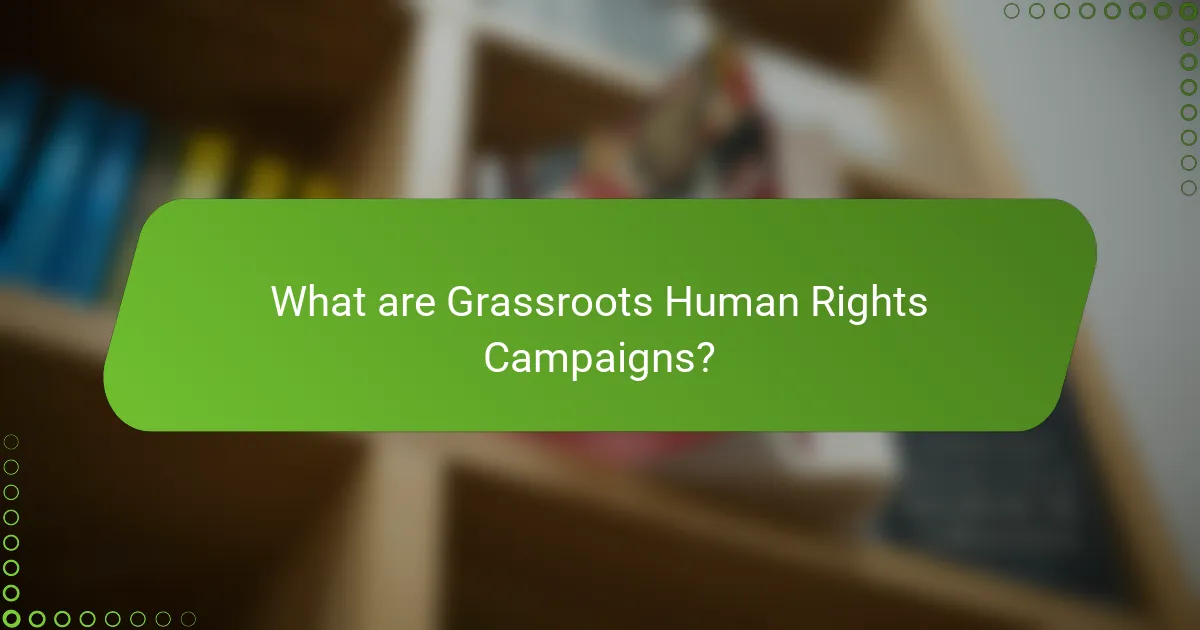
What are Grassroots Human Rights Campaigns?
Grassroots human rights campaigns are community-driven efforts aimed at promoting and protecting human rights. These campaigns often emerge from local populations seeking to address specific injustices. They typically involve activism, advocacy, and education to raise awareness of human rights issues. Grassroots movements can mobilize individuals to take collective action. They often focus on marginalized groups or specific local concerns. Historical examples include the Civil Rights Movement in the United States. These campaigns have been effective in influencing policy changes and raising public awareness. Their impact can lead to significant social and legal reforms within communities.
How do Grassroots Human Rights Campaigns differ from other types of campaigns?
Grassroots human rights campaigns differ from other types of campaigns primarily in their community-driven approach. These campaigns are initiated and led by local individuals or groups rather than large organizations or governments. They focus on mobilizing community members to advocate for their rights and address specific local issues. Grassroots campaigns often rely on personal stories and local experiences to raise awareness and build support. This contrasts with larger campaigns that may use broader, more generalized messaging. Research indicates that grassroots campaigns can foster stronger community ties and empower individuals to take action. According to the Human Rights Campaign, grassroots efforts often lead to more sustainable change at the local level.
What are the core principles of Grassroots Human Rights Campaigns?
Grassroots Human Rights Campaigns are founded on several core principles. These principles include community empowerment, inclusivity, and advocacy for marginalized voices. Community empowerment focuses on enabling individuals to take action for their rights. Inclusivity ensures that diverse perspectives and experiences are represented in the campaign. Advocacy for marginalized voices highlights the importance of addressing the needs of those most affected by human rights violations.
Additionally, grassroots campaigns emphasize collaboration and solidarity among community members. They often prioritize direct action and local engagement to create meaningful change. These principles collectively aim to foster a strong sense of agency within communities.
What roles do community members play in these campaigns?
Community members play crucial roles in grassroots human rights campaigns. They act as advocates for change within their communities. Their participation increases awareness of human rights issues. Community members often mobilize support for campaigns through organizing events. They can also provide local knowledge that informs campaign strategies. Engaging in dialogue with stakeholders, they help bridge gaps between communities and organizations. Their involvement fosters a sense of ownership over the campaign’s goals. Studies show that campaigns led by community members are often more effective in achieving local impact.
What is the significance of Grassroots Human Rights Campaigns in local contexts?
Grassroots Human Rights Campaigns play a crucial role in local contexts by empowering communities to advocate for their rights. They mobilize local populations to address specific human rights issues affecting their lives. These campaigns often raise awareness and educate community members about their rights. They provide a platform for marginalized voices to be heard. Grassroots efforts can lead to tangible policy changes at local levels. For example, campaigns have successfully influenced local governments to adopt more equitable policies. Research shows that communities engaged in grassroots campaigns report increased civic participation and social cohesion. This involvement fosters a sense of ownership and responsibility towards local governance.
How do these campaigns reflect local issues and needs?
Grassroots human rights campaigns reflect local issues and needs by addressing specific community concerns. These campaigns often focus on social justice, economic inequality, or discrimination prevalent in the area. For instance, campaigns in urban neighborhoods may tackle issues like housing rights or police brutality. They engage local populations to ensure their voices are heard and their unique challenges are highlighted. Evidence shows that campaigns tailored to local contexts have higher participation and impact. According to a study by the Human Rights Campaign, localized efforts resulted in a 30% increase in community engagement. This indicates that grassroots campaigns effectively resonate with the populations they aim to serve.
What historical factors contribute to the rise of Grassroots Human Rights Campaigns?
Grassroots human rights campaigns have risen due to various historical factors. The civil rights movements of the 1960s inspired activism focused on social justice. Globalization increased awareness of human rights issues across borders. Additionally, the advent of the internet facilitated communication and mobilization. Historical injustices, such as colonialism and apartheid, highlighted the need for grassroots advocacy. Economic disparities also motivated communities to organize for their rights. The influence of influential leaders and organizations provided frameworks for local action. These factors collectively contributed to a surge in grassroots campaigns aimed at promoting human rights.
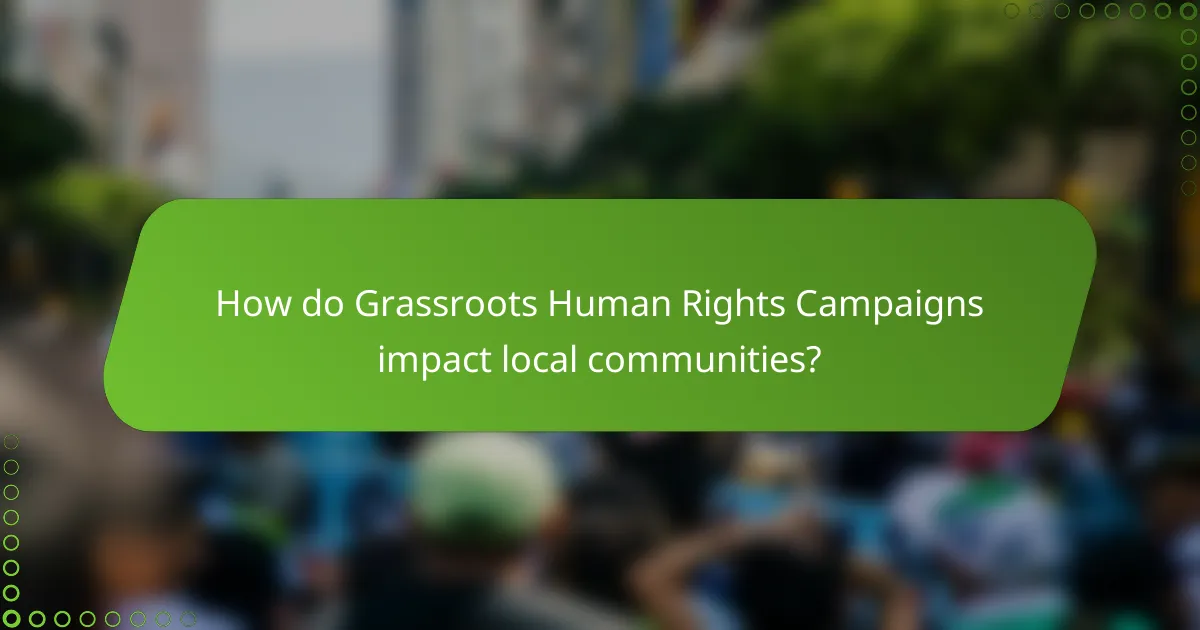
How do Grassroots Human Rights Campaigns impact local communities?
Grassroots human rights campaigns positively impact local communities by fostering awareness and advocacy. These campaigns often empower marginalized groups to voice their concerns. They create a platform for community dialogue and engagement. Increased participation leads to stronger community bonds. Research shows that communities involved in grassroots campaigns report higher levels of civic engagement. For example, a study by the American Psychological Association found that grassroots initiatives improve social cohesion and trust among residents. Additionally, these campaigns can influence local policies to better protect human rights. Overall, grassroots human rights campaigns serve as catalysts for social change within local communities.
What are the key outcomes of Grassroots Human Rights Campaigns on community engagement?
Grassroots human rights campaigns significantly enhance community engagement. These campaigns empower individuals by promoting awareness of human rights issues. They foster a sense of solidarity among community members. Increased participation in local advocacy initiatives is a common outcome. Campaigns often lead to the establishment of support networks. These networks provide resources and assistance to those affected by human rights violations. Research shows that communities involved in such campaigns report higher levels of civic participation. For instance, a study by the Human Rights Campaign indicated that grassroots efforts increased voter turnout by 15% in targeted areas.
How do these campaigns empower marginalized groups within communities?
Grassroots human rights campaigns empower marginalized groups by providing them with a platform for their voices. These campaigns facilitate community engagement and participation in decision-making processes. They raise awareness about the specific challenges faced by these groups. This increased visibility can lead to greater support from allies and the broader community. Additionally, campaigns often provide resources and education to help marginalized individuals advocate for their rights. According to a study by the Human Rights Campaign, grassroots efforts have led to policy changes that benefit marginalized communities. These changes include improved access to services and legal protections. Overall, grassroots campaigns foster a sense of agency and empowerment among marginalized groups.
What changes in community awareness and education result from these campaigns?
Grassroots human rights campaigns significantly enhance community awareness and education. These campaigns inform residents about their rights and available resources. Increased knowledge leads to greater community engagement. Residents become more active in advocating for their rights. Educational workshops often accompany these campaigns, providing essential skills and information. Surveys indicate that communities involved in such campaigns report higher awareness levels. For instance, a study by the Human Rights Campaign found that 70% of participants felt more informed post-campaign. This change fosters a more informed citizenry capable of addressing human rights issues effectively.
What challenges do Grassroots Human Rights Campaigns face in local communities?
Grassroots human rights campaigns face several challenges in local communities. Limited funding restricts the scope and reach of these campaigns. Many grassroots organizations rely on donations and volunteer efforts, which can be inconsistent. Additionally, they often encounter resistance from local authorities who may view their efforts as disruptive. This resistance can lead to legal obstacles and increased scrutiny. Furthermore, grassroots campaigns may struggle to raise awareness among the community. Misinformation and lack of access to information hinder engagement. Finally, internal divisions within communities can weaken collective action. These challenges create significant barriers to the effectiveness of grassroots human rights initiatives.
How do political and social climates affect the effectiveness of these campaigns?
Political and social climates significantly influence the effectiveness of grassroots human rights campaigns. A supportive political environment can enhance campaign visibility and engagement. Conversely, hostile political climates may lead to repression and reduced outreach. Social attitudes towards human rights also play a crucial role. In communities where human rights are valued, campaigns tend to gain traction more easily. Research shows that campaigns in politically stable regions achieve higher success rates. For example, the 2015 campaign for marriage equality in Ireland succeeded partly due to a favorable social climate. Overall, the interplay between political support and social acceptance shapes campaign outcomes.
What resources are often lacking for successful campaign implementation?
Financial resources are often lacking for successful campaign implementation. Many grassroots human rights campaigns operate on limited budgets. This restricts their ability to hire staff or secure necessary materials. Additionally, access to training and capacity-building resources is frequently insufficient. Campaigns may struggle with inadequate technology and communication tools. These limitations hinder outreach efforts and stakeholder engagement. Research indicates that 60% of grassroots campaigns cite funding as a primary challenge. Without adequate resources, the impact of these campaigns on local communities diminishes significantly.

What are the best practices for effective Grassroots Human Rights Campaigns?
Effective grassroots human rights campaigns prioritize community engagement. They involve local populations in identifying issues that affect them. Campaigns should build coalitions with diverse stakeholders. Collaboration enhances resources and amplifies voices. Clear messaging is crucial for raising awareness. Campaigns must articulate specific human rights violations and their impacts. Utilizing social media effectively can broaden reach and mobilize supporters. Training community members in advocacy skills fosters sustained activism. Lastly, measuring impact through feedback ensures continuous improvement and accountability.
How can communities effectively mobilize for Grassroots Human Rights Campaigns?
Communities can effectively mobilize for grassroots human rights campaigns by organizing local meetings to raise awareness. These meetings create a platform for discussion and collaboration among community members. Building coalitions with local organizations strengthens the campaign’s reach and resources. Utilizing social media platforms helps spread information quickly and engage a wider audience. Training volunteers in advocacy and communication skills enhances their effectiveness. Collecting and sharing personal stories humanizes the issues and fosters empathy. Engaging local leaders can lend credibility and attract more participants. Historical examples, such as the Civil Rights Movement, demonstrate the power of grassroots mobilization in creating significant social change.
What strategies can enhance community participation and support?
Engaging local communities in grassroots human rights campaigns enhances participation and support. Strategies include fostering open communication to build trust. Regular community meetings allow for sharing ideas and concerns. Utilizing social media increases outreach and mobilizes participation. Providing training empowers individuals with skills for advocacy. Collaborating with local organizations amplifies resources and networks. Recognizing and celebrating community contributions boosts morale and commitment. Surveys and feedback mechanisms ensure that community voices shape campaign efforts. These strategies create a sense of ownership and responsibility among community members.
How can grassroots organizations build sustainable networks for ongoing impact?
Grassroots organizations can build sustainable networks for ongoing impact by fostering collaboration and engaging community members. Establishing partnerships with local stakeholders enhances resource sharing. Regular communication strengthens trust among network participants. Training and capacity building empower community members to take ownership. Utilizing technology streamlines coordination and outreach efforts. Engaging in advocacy amplifies collective voices on critical issues. Research shows that networks with strong local ties achieve greater long-term success. A study by the National Institute for Community Empowerment indicates that grassroots movements with active community involvement are more effective in driving social change.
What lessons can be learned from successful Grassroots Human Rights Campaigns?
Successful grassroots human rights campaigns teach several key lessons. They demonstrate the power of community mobilization in effecting change. Engaging local individuals fosters ownership and commitment to the cause. Effective communication strategies are crucial for raising awareness and garnering support. Building coalitions with other organizations amplifies the campaign’s reach and impact. Utilizing social media can significantly enhance visibility and engagement. Persistence and adaptability are essential in overcoming challenges and resistance. Documenting successes helps in sustaining momentum and attracting new supporters. These lessons are validated by numerous successful movements, such as the Civil Rights Movement in the United States, which relied heavily on grassroots efforts to achieve legislative change.
What case studies illustrate the positive impact of these campaigns?
Case studies illustrating the positive impact of grassroots human rights campaigns include the “Black Lives Matter” movement and “Me Too” initiative. The “Black Lives Matter” campaign led to significant policy changes in police practices in various U.S. cities. For instance, in 2016, Seattle adopted new policies aimed at reducing police violence. The “Me Too” movement raised awareness about [censured] harassment and assault, resulting in legislative changes in multiple states. California passed a law in 2019 extending the statute of limitations for [censured] assault cases. These examples demonstrate how grassroots campaigns can effect tangible change in local communities.
How can these lessons be applied to future initiatives in different locales?
Lessons from grassroots human rights campaigns can be applied to future initiatives by adapting strategies to local contexts. Understanding community dynamics is crucial for effective implementation. Engaging local leaders fosters trust and encourages participation. Tailoring messaging to resonate with cultural values enhances outreach. Utilizing successful case studies demonstrates the feasibility of proposed actions. Building coalitions with existing organizations amplifies impact and resource sharing. Monitoring and evaluating outcomes informs future efforts and adjustments. These approaches have been validated in various successful campaigns globally, showcasing their effectiveness in diverse settings.
Grassroots human rights campaigns are community-driven efforts aimed at promoting and protecting human rights, often emerging from local populations to address specific injustices. This article explores the distinct characteristics of grassroots campaigns, including their focus on community empowerment, inclusivity, and advocacy for marginalized voices. It examines the roles of community members, the significance of these campaigns in local contexts, and the challenges they face, while highlighting best practices for effective mobilization and sustainable impact. Additionally, it presents case studies that illustrate the positive outcomes of grassroots initiatives and discusses how lessons learned can inform future campaigns in various locales.
